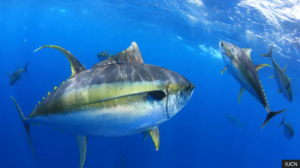Physical Address
23,24,25 & 26, 2nd Floor, Software Technology Park India, Opp: Garware Stadium,MIDC, Chikalthana, Aurangabad, Maharashtra – 431001 India
Physical Address
23,24,25 & 26, 2nd Floor, Software Technology Park India, Opp: Garware Stadium,MIDC, Chikalthana, Aurangabad, Maharashtra – 431001 India

Tuna are suffering from lack of oxygen, says IUCN, Pic courtesy: IUCN
By G.R. Diwyanjalee
The coastal ocean off the United States Pacific Northwest is facing a growing environmental challenge: near-bottom hypoxia. This condition, characterized by dangerously low levels of dissolved oxygen, poses a significant threat to marine ecosystems and local economies reliant on fisheries. Over the past 15 years, this region has experienced substantial ecological shifts, driven by a combination of climate change and other stressors.
The Coastal Ocean off the United States Pacific Northwest
The coastal ocean off the Pacific Northwest, extending from northern California to Washington, is part of the California Current System, one of the world’s major coastal upwelling regions. This area is characterized by a dynamic interplay of physical and biological processes driven by seasonal wind patterns, which bring nutrient-rich, low-oxygen waters to the surface, fueling high productivity. The region supports vibrant marine ecosystems, including kelp forests, seagrass beds, and economically important fisheries for species like Dungeness crab and groundfish.
Scientific Theory behind Near-Bottom Hypoxia
Hypoxia occurs when dissolved oxygen levels in the water drop below the threshold necessary to sustain most marine life, typically below 61 µmol kg−1. In the Pacific Northwest, this phenomenon is primarily driven by upwelling of deep, low-oxygen waters, compounded by respiration of organic matter. Climate change exacerbates this condition by increasing water temperatures and altering wind patterns, which intensify upwelling and reduce oxygen solubility in seawater.
Investigating historical oceanic anoxia events, like the Cambrian “SPICE” event, provides crucial insights into the possible impacts of current environmental trends. Studies from the University of Copenhagen revealed that phosphorus recycling from ocean sediments under anoxic conditions played a key role in historic oxygen declines. These findings underscore the complex interplay of biogeochemical processes that can exacerbate hypoxia in modern oceans. To see how the Cambrian ‘SPICE’ event’s phosphorus-induced oxygen depletion in oceans,SciTechDaily.com
Pic courtesy: Minhan Dai
A pivotal study by researchers at Oregon State University documented widespread near-bottom hypoxia during the summer of 2021. Led by oceanographer John A. Barth, the team utilized ship and underwater glider measurements, revealing that nearly half of the continental shelf inshore of the 200-m isobaths experienced hypoxic conditions. The affected area spanned approximately 15,500 square kilometers, significantly larger than previous years and indicative of a troubling trend towards lower oxygen levels over time.
Long-term Trends (1950-2021): Analysis of historical data from 1950 to 2021 shows a consistent decline in near-bottom dissolved oxygen levels. The fraction of hypoxic waters increased from nearly nonexistent (2%) in 1950-1980 to 24% in 2009-2018, and further to 56% during the strong upwelling of 2021. This trend aligns with increased upwelling-favorable wind conditions predicted under climate change scenarios.
“The widespread hypoxia observed during the summer of 2021 is a stark indicator of how climate change is impacting our coastal waters. The increasing prevalence of low-oxygen conditions poses a significant threat to marine life and the sustainability of important fisheries in the Pacific Northwest,” said Barth, highlighting the urgency of addressing this environmental challenge.
Pic courtesy: Barth, John A., et al (2024)
Ecological Impact: The decline in oxygen levels is linked to significant ecological changes along the Pacific Northwest coast. Over a 15-year period ending in 2020, the region experienced both a marine heat wave and a sea star wasting disease epidemic. These events drastically altered species composition on rocky shores, with a marked increase in sessile invertebrates like mussels and barnacles, and a decline in kelps, which are less resilient to thermal stress. Sea stars, key predators in these ecosystems, play a crucial role in maintaining balance by preying on mussels and barnacles.
Dungeness crab, a pillar of Washington’s seafood industry, relies on plentiful oxygen near the bottom of the ocean to survive. (Pic courtesy: Oregon Sea Grant)
Sea stars in Pacific Northwest ecosystems are being tested by climate change. Pic courtesy: Earth
“Sea stars are like the wolves of rocky shores because they normally eat enough mussels and barnacles to prevent these invertebrates from dominating the lower elevation areas. Many kelps did not survive the thermal stress during the heat wave,” noted Zechariah Meunier, a doctoral graduate, emphasizing the critical role of these predators in maintaining ecosystem balance.
The OOI’s (Ocean Observatories Initiative) Endurance Array, deployed off the coasts of Oregon and Washington, provides critical data on ocean conditions, enabling researchers to monitor changes in real-time. This initiative has been instrumental in documenting phenomena like low-oxygen events and marine heat waves, which have profound effects on the region’s marine ecosystems.
Therefore, the increasing near-bottom hypoxia in the coastal ocean off the United States Pacific Northwest is a multifaceted issue with significant ecological and economic implications. As climate change continues to alter oceanographic processes, the region’s marine ecosystems face unprecedented challenges. Continued monitoring, research, and adaptive management strategies are essential to mitigate the impacts and preserve the health and productivity of these vital coastal waters.